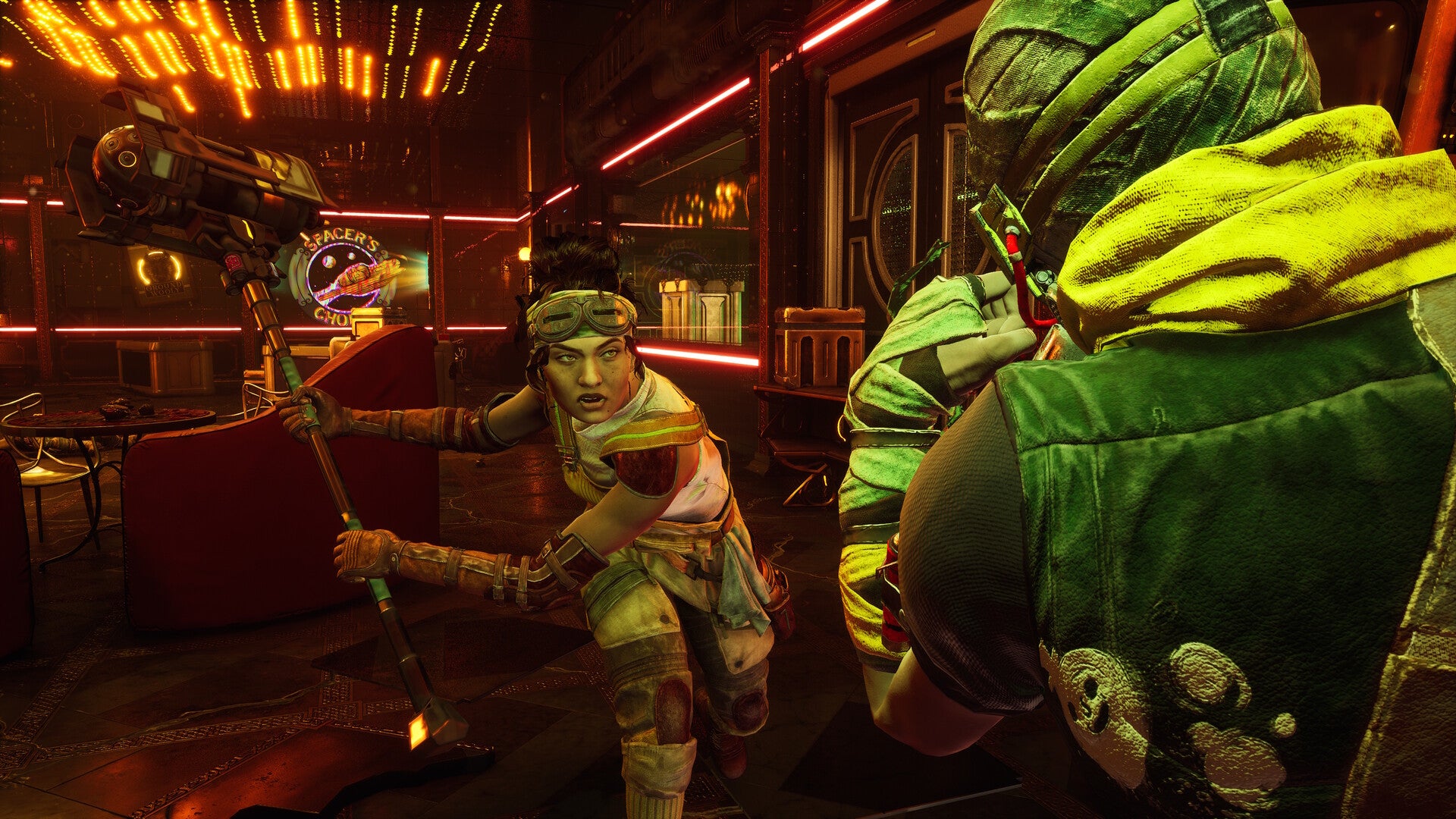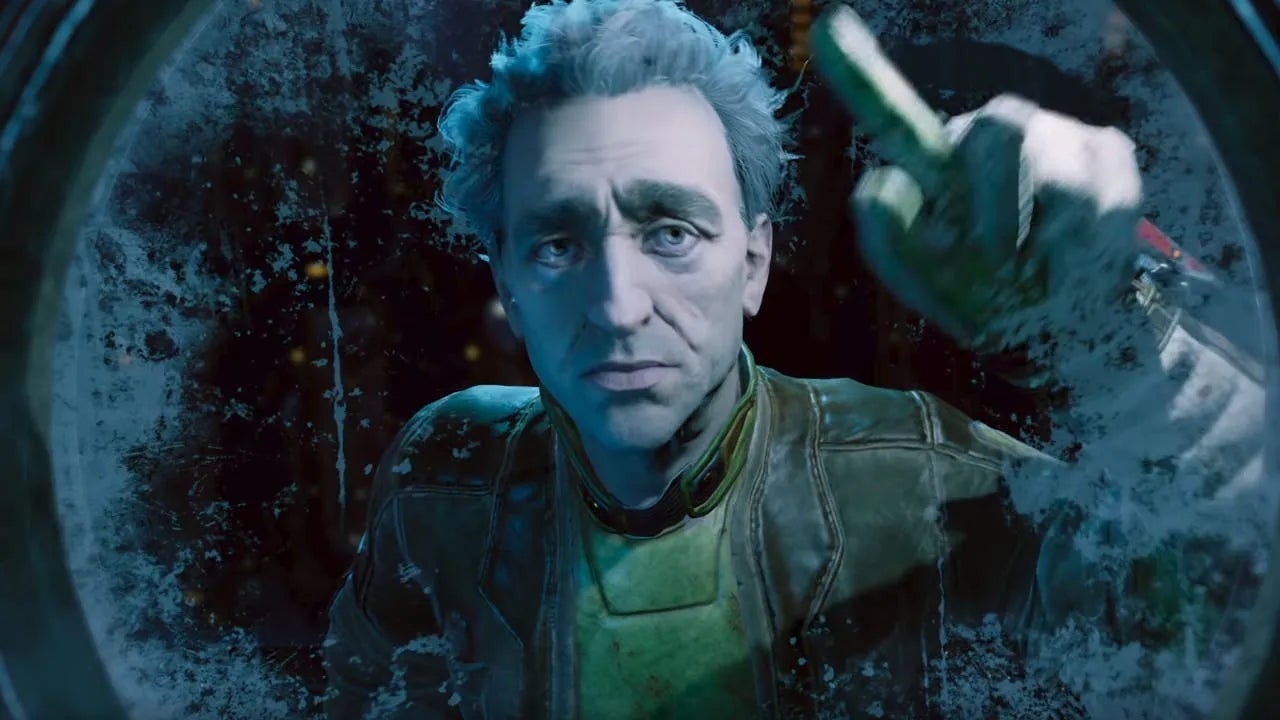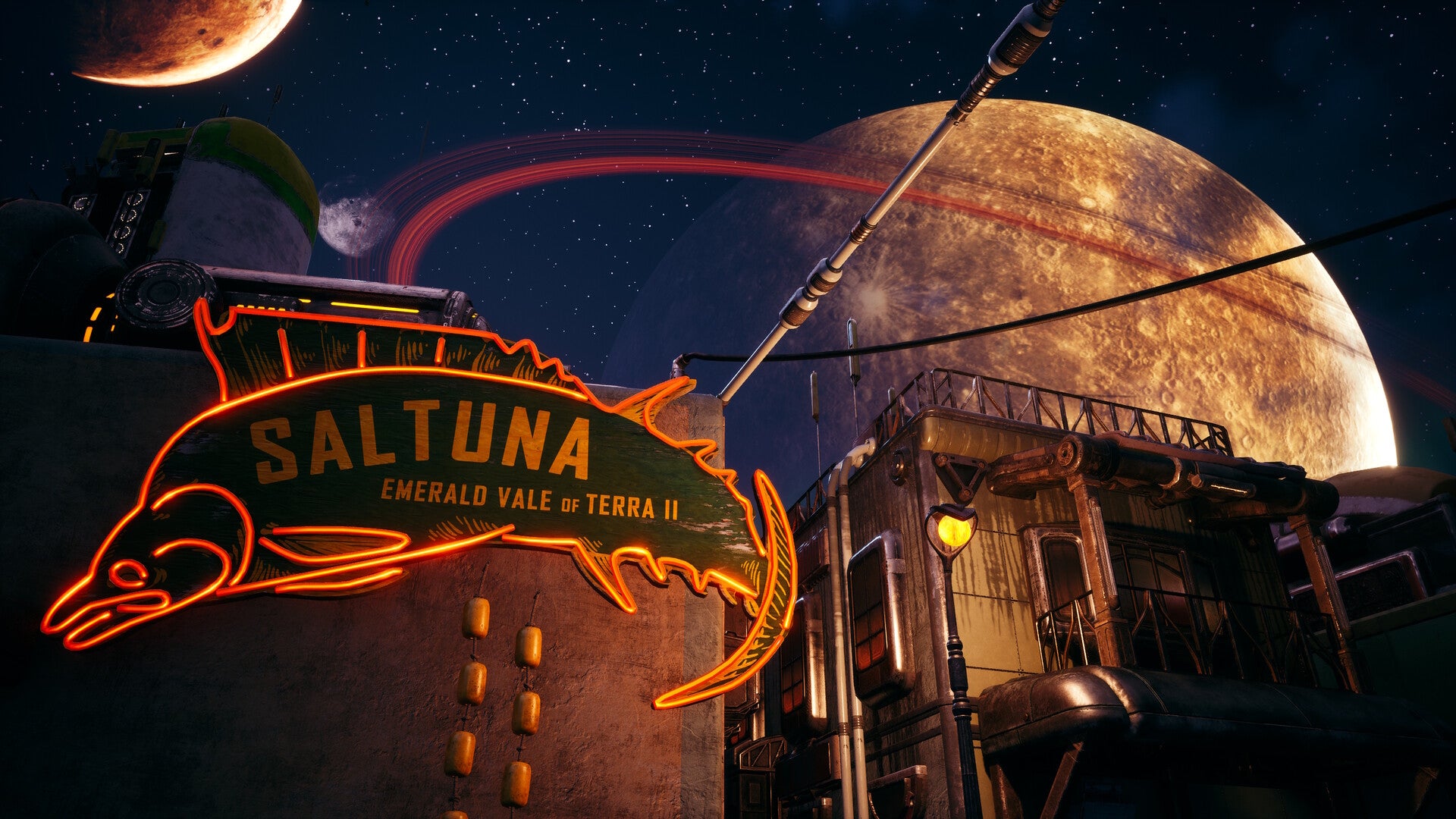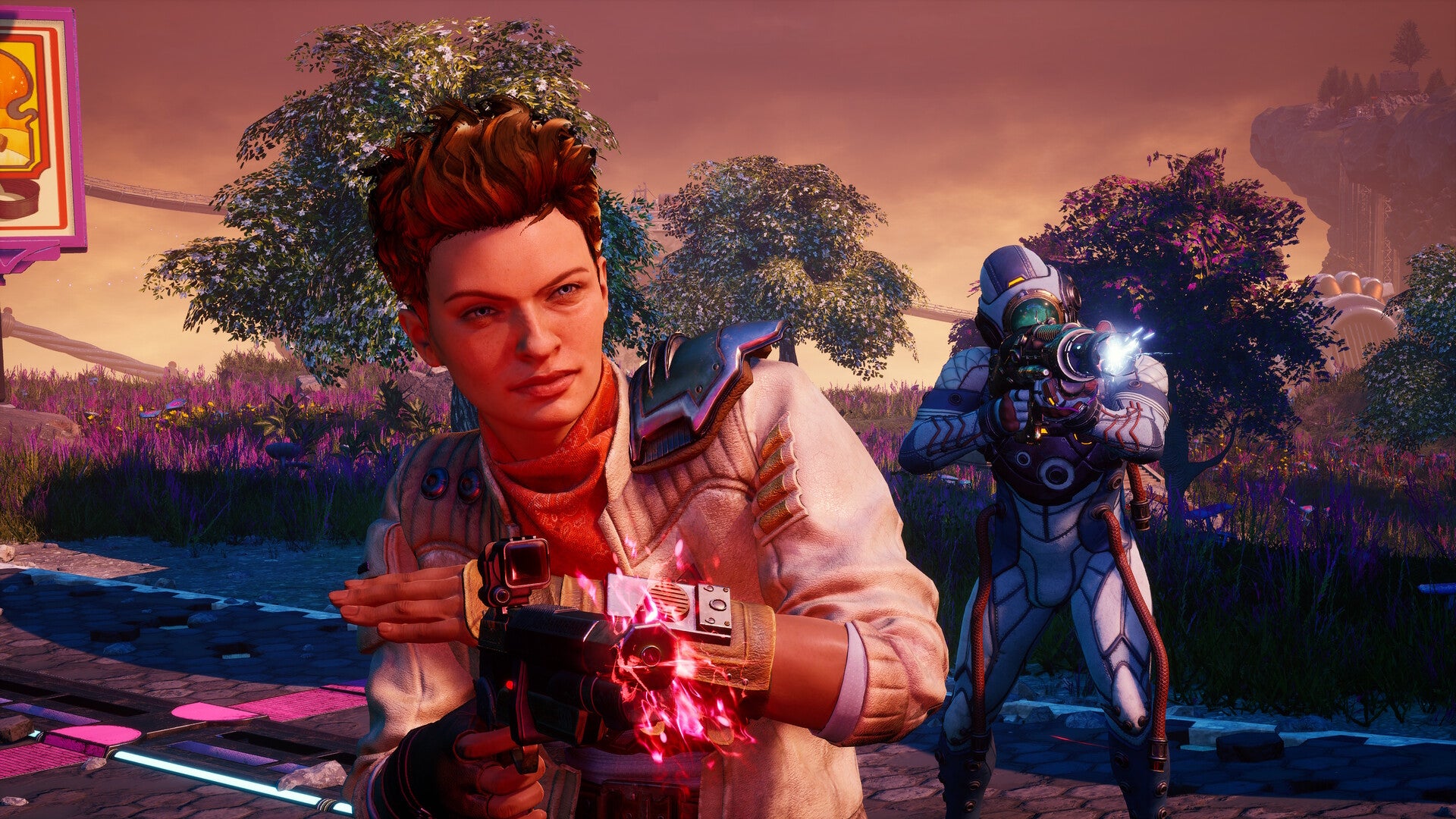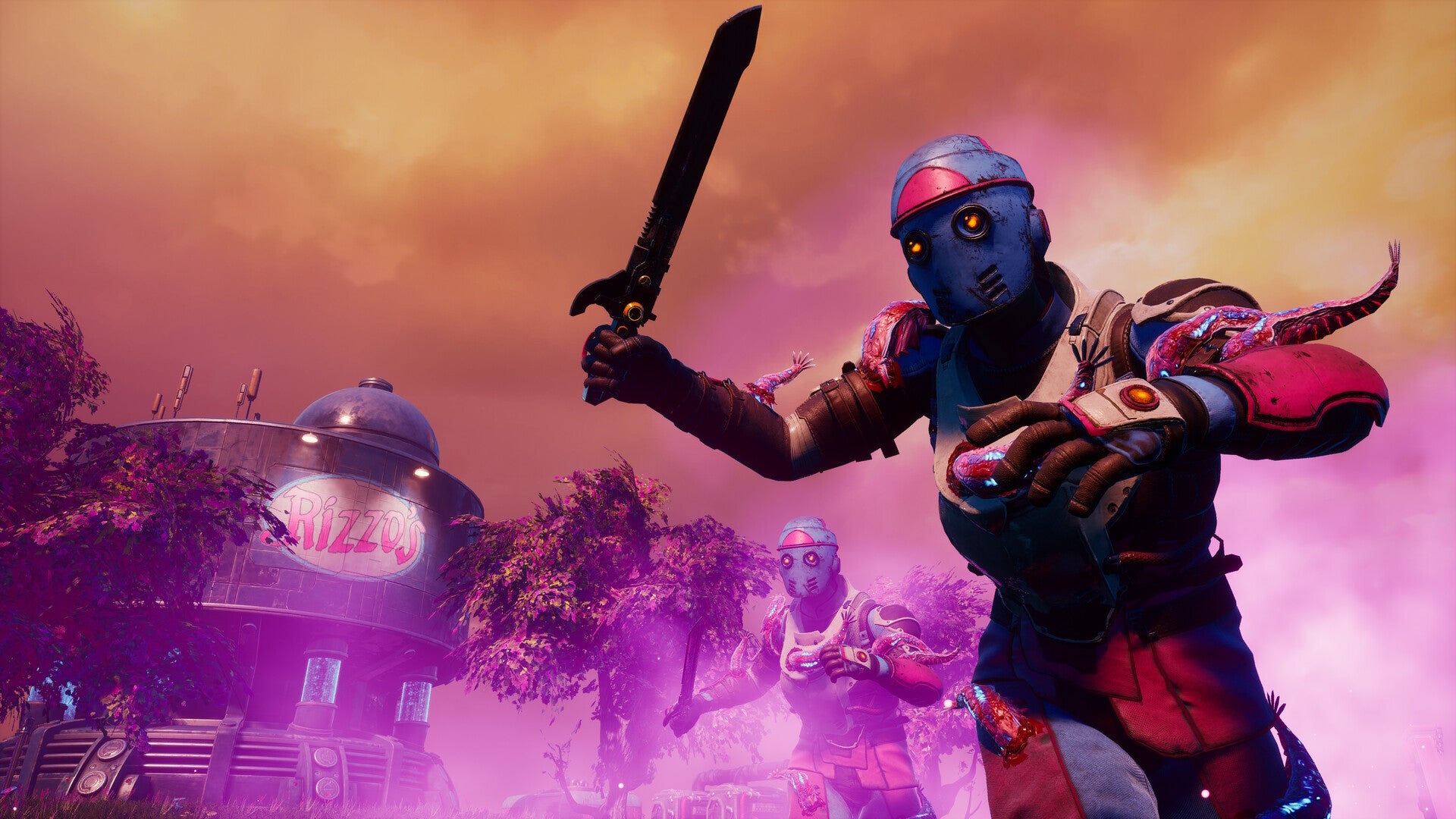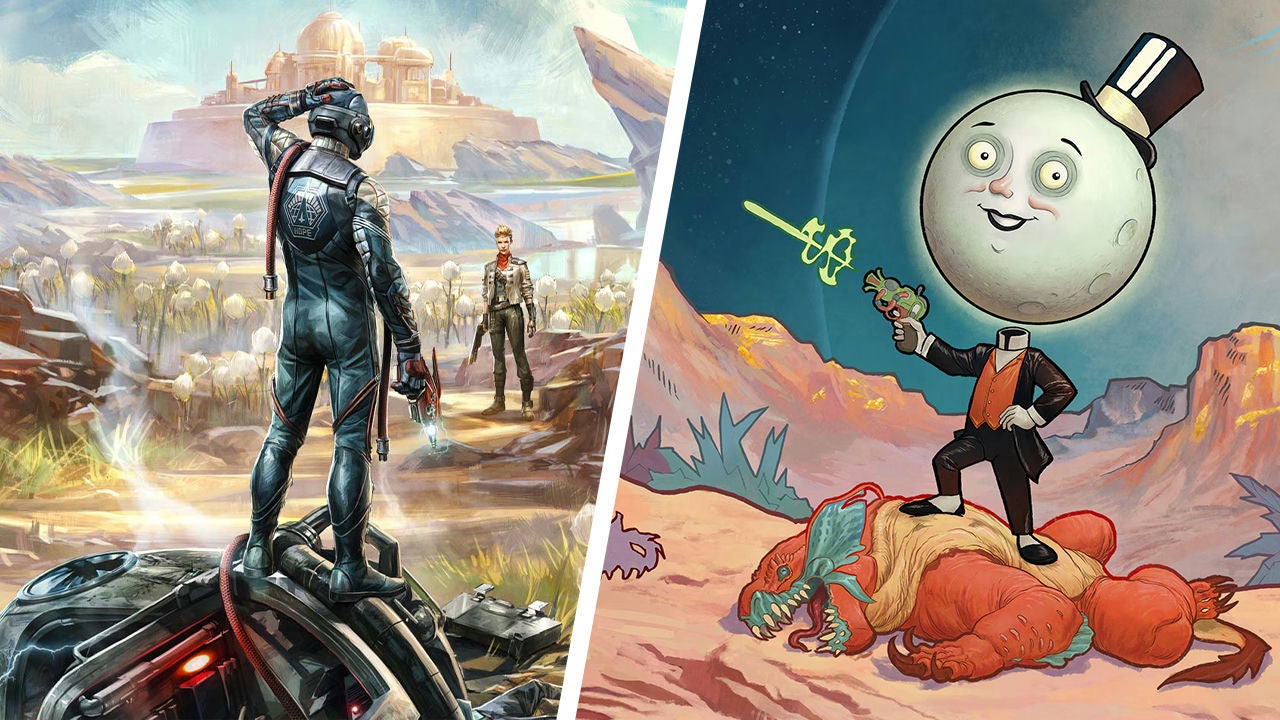
This article contains spoilers for 2019’s The Outer Worlds.
With The Outer Worlds 2 imminently about to drop, we think it’s a good time to brush up on the fundamentals of Obsidian’s high-concept sci-ifi universe and recount the events of the first game. The next 2,000 words or so will work nicely as a refresher for people who finished The Outer Worlds ages ago, and also as a primer for those of you diving into the sequel without any prior knowledge. It goes without saying, then, that what follows contains spoilers for The Outer Worlds 1. If you don’t want anything spoiled… well, the long and short of it is that unregulated capitalism is bad. That’s enough to get you going with The Outer Worlds 2.
But you didn’t come here for tl;dr. You clicked on an article to read it, so here’s everything that happened in The Outer Worlds.
Divergence
The Outer Worlds’ story arguably starts in 1901 with a non-event. That is, President William McKinley not getting assassinated by an anarchist for failing to regulate the corporations, and subsequently, uh, leaving the corporations unregulated for the rest of his term and apparently for the rest of time, putting humanity on course to colonise the stars, but as an entrenched, hyper-capitalist society in which workers rights are not remotely a concept. So this is like a nightmare version of Star Trek where everything sucks unless you’re absurdly rich. Thank god this is just fiction.
Fast forward a few hundred years, and The Earth Directorate, a one-world government established after a devastating war, is granting licenses to various conglomerates to go off and colonise distant planets, the titular Outer Worlds. We don’t know exactly how many galaxies have been colonised, but multiple systems are mentioned through the course of the game, including Septerra, Tyrannus, Draconis, and from the upcoming Outer Worlds 2, Arcadia.
The Outer Worlds 2 isn’t a direct sequel to its predecessor, so that’s technically everything you need to know. But there’s every chance that someone or something from the original game will make an appearance, be that as a side character, easter egg, or even an important event in the story. So read on to brush up on everything that happens prior to your adventure in game two.
Lost Hope
Our story occurs in the troubled system of Halcyon, and that trouble starts before the colonisation effort even reaches the system. Of the two vast colony ships sent there, only one arrives on time – The Groundbreaker. After seeding all the inhabitable planets with colonists, it becomes an independent freeport space station and floating strip mall, an essential hub for trade at the intersection between small time private enterprise and the rest of the corporation-controlled system. The second ship, the Hope, carrying tens of thousands of scientists and thinkers in suspended animation, has a skip drive malfunction enroute from Earth and ends up limping to Halcyon at sublight speeds.
Presumed lost, it is then discovered by The Board, Halcyon’s corporate overlords, and instead of being allowed to complete its journey, it is tethered to a remote ice moon and hidden from view. The Board don’t have the tech or the will to revive the Hope colonists, and they don’t want to have to deal with a public outcry about it, either. And so they are content to let it remain frozen and forgotten in time.
This, however, irks one of their scientists, one Phineas Welles, who is so incensed by The Board’s inaction that he takes matters into his own hands and starts experimenting, in secret, on the Hope’s colonists in order to find a viable method of resurrecting them after all this time. He succeeds, but not before becoming a disgraced outlaw and the most wanted man in the entire system.
Unfortunately, the resurrection process requires lots of rare material that’s difficult to gather when you’re on the run, and so Phineas decides to use his one and only test batch of revival serum on a single Hope colonist. In a last-ditch raid on the abandoned starship, he selects someone to revive at random in the hopes that they will become a loyal ally and help him finish his grand scheme: to revive every Hope colonist, seed the Halcyon system with smart people who aren’t idiots, and free the colonies from corporate control. He successfully does so, but not without his own ship sustaining significant damage, grounding it permanently.
Who he revives depends on you, the player, and their skills and character traits depend on your choices in both the character creator and the game’s narrative. And so begins a grand choice and consequence story in which the optimum outcomes are locked behind gates of competency – that is, if this heroic Stranger wants to achieve the most free and least bloody outcome for the people of Halcyon, they’re gonna need to pass some lofty speech checks. And we’re assuming that’s what they did, because covering every possible permutation of The Outer Worlds’ story would take far more time than any of us reasonably has.
The Unplanned Variable
Before the player character arrives – almost forty years late – to the Halcyon system, The Board is content to preside over a system of shocking inequality, maintaining control through stifling bureaucracy and manufactured scarcity. But not every worker is a mindless drone, as we find out in Emerald Vale: the first major test of The Stranger’s resourcefulness, charisma, and political savvy – an opening chapter that sets the blueprint for all the conflicts to come.
But first, The Stranger needs a ride, and a guide. Welles arranges with a known privateer and general Han Solo archetype, Captain Hawthorn, to meet The Stranger on the planet Terra 2. Unfortunately what Hawthorn actually meets is the Stranger’s drop pod, violently, with the top of his head. This leads The Stranger to commandeer Hawthorn’s now captainless ship, The Unreliable – a sort of chubby Millennium Falcon with a feisty onboard computer – and take off on a grand interplanetary adventure.
Uh, except, not yet: it turns out that The Unreliable needs a replacement power regulator before it can go, which is annoying, but the pursuit of a new one does give The Stranger an opportunity to recruit two immensely useful companions: engineer Parvati and philosophical space-priest Vicar Max, both of whom provide boosts to The Stranger’s crucial Persuade and Intimidate skills, vital for the wheeling and dealing that lies ahead.
After checking in with the boss of Emerald Vale’s biggest corporate town and Spacer’s Choice Saltuna cannery, Reed Tobson, it turns out that there are two power regulators in the area: one in his factory, which he is understandably reluctant to give up, and one at an abandoned Botanical Lab, now home to a set of deserters who, disillusioned with the systemic mistreatment they experienced as lifelong, sometimes multi-generational indentured employees of Spacer’s Choice, have decided to found a new cooperative society free from company oversight. Unfortunately, this means that the Saltuna Cannery is chronically understaffed, and so Reed asks you to cut off their power at the local plant in order to force his workers back into the fold, which will make it safe for you to nab their power regulator.
It seems like a solid plan, but it does come with the downside of propping up an odious bootlicking toad like Reed at the expense of people whose only crime is wanting to be free of a system that is hostile to them. The obvious alternative is to screw him over and divert power to the Botanical Lab, but effectively killing the town of Edgewater at the same time – not only is Edgewater a safe walled city where people live, it is also the home of companion Parvati, so destroying it comes with a significant personal cost.
There is, however, an optimal solution: The Stranger decides to shut down the Botanical Labs and take its power regulator, initially making an enemy of the deserter leader Adelaide, but convinces Reed Tobson to step down as leader of Edgewater, cleverly using his own company loyalty against him by pointing out that he’s remarkably crap at his job, and that the best outcome for Spacer’s Choice is for him to just disappear. Morbid, sure, but they could have just shot him, so this really is the best outcome for all concerned. The Deserters return to the town, Adelaide takes over as administrator from Reed, and sets about making the colony more sustainable by growing food in soil enriched by, uh, corpses. Which is fine. Look, however you slice it, life is cheap here. There is, as it turns out, no perfect solution to any of Halcyon’s problems – but this way, the people of Edgewater get a little more health and happiness without having to give up the corporate infrastructure they so rely on.
Groundbreaker
With a freshly installed power regulator and an eager new crew, The Stranger sets off to Groundbreaker Station, Halcyon’s premiere shopping destination and hive of scum and villainy. Most of it of the white collar variety.
There, they recruit two more companions: Felix, a canny dockworker with a high Persuade boost, and Ellie, a roving sawbones loyal only to her next pay packet who comes complete with a boost to the party’s lying skills.
The Stranger’s next task involves visiting the moon of Monarch, but this is tricky because the planet has been deemed off-limits by The Board as it is subject to an entrenched civil war and a communications blackout. Having been cut off from board oversight, it’s generally assumed that the place is bad news. Bad News, however, is The Stranger’s middle name. Or names. It’s not really. But look, nothing will deter The Stranger from going there, not even a corporate embargo or risk of certain death. They demonstrate this determination by doing a bunch of busywork in another semi-abandoned corporate settlement just to get enough bits to buy an illicit black market navkey to the town of Stellar Bay in the Cascadia region of Monarch.
Clearing the Air
Phineas needs to procure a rare substance called Dimethyl Sulfoxide in large quantities to revive all the colonists still frozen on The Hope. To track some down, he’s made a deal with an information broker on Monarch with the help of Nyoka, The Unreliable’s final recruitable companion, but has yet to receive the intel for reasons unknown. So he sends The Stranger there in his stead to find and retrieve this vital piece of the puzzle.
Upon arriving on Monarch, The Stranger makes contact with Nyoka and sets off to Devil’s Peak, the ominous horned mountain that hosts a large communications station where the Information Broker is currently holed up, and learns (after doing lots of murder, like, loads and loads of it) that the reason Phineas hasn’t received the intel is that the region’s communications are being drowned out by pervasive broadcasts by Monarch Stellar Industries, the corporate remnant still holding onto power on Monarch, and The Iconoclasts, a group of anarchists determined to free the colony of Board control.
This is like the Edgewater vs Deserters situation on steroids, and confirms what Phineas has told you about Halcyon: the system is falling apart, and The Board are content to let it, rather than relinquish its stranglehold on the workers. But The Stranger is remarkably good at brokering impossible deals – getting people from opposing factions to see reason, and work together toward a common goal. They work this magic on Monarch, first to end the broadcasts and free up the comms tower to send Phineas his intel, and then – just as an encore, you understand – put an end to the conflict entirely with a little deposing here, a bit of finessing there. Turns out diplomacy’s a piece of piss.
Byzantium
Sorting out the mess on Monarch provided a strong foundation for the health of the Halcyon system going forward, but there still remained the issue of The Board and their sheer indifference to the horrific conditions that people are having to live with outside of their glittering capital city of Byzantium – which is exactly where the intel sends The Stranger in order to retrieve those vital chemicals, which are being used by The Board to run experiments on human test subjects in suspended animation.
It turns out that The Board’s answer to the Halcyon system’s collapsing economy and total lack of food security is the Lifetime Employment Program – a scheme where all of Halcyon’s workers will be placed in indefinite suspended animation, revived only when needed, in order to reserve the colony’s dwindling food supplies for the societal elite in Byzantium. And, y’know, their scientists will totally get onto fixing the whole food shortage thing in the meantime. Definitely. Yep. Oh, and this involves killing everyone left on board The Hope to make space in the fridge for this planned batch of worker popsicles.
This being unconscionable, The Stranger shuts down the board’s research and retrieves the Dimethyl Sulfoxide, the second to last piece of the puzzle needed to revive the Hope colonists. The final piece being the ship itself.
Endgame
Phineas sends The Stranger back to where it all started, the Hope, with a plan to restart its skip drive and bring it to Terra 2, so the work of reviving its colonists – said to be Halcyon’s best and brightest – can get underway. It is Phineas’s belief that they will be able to solve the colony’s food shortages and systemic conflicts with science, technology, and pragmatism.
Once the ship is retrieved, though, it is discovered that Phineas’s secret lab has been ransacked, and he himself imprisoned on Tartarus, Halcyon’s infamous penal colony. The fight that ensues involves almost everyone The Stranger helped out on their travels up to that point – with both the MSI and the Iconoclasts showing up as allies to assist in this cosmic prison break, along with the crew of The Groundbreaker itself.
Despite a certain acceptable level of bloodshed being inevitable, The Stranger’s progressive reputation, history of even-handed pragmatism, and relative lack of a murderous streak puts them in a position to negotiate peacefully for Phineas’s release, locking in his vision for reviving the Hope colonists, and setting its brilliant thinkers on the path to fixing the colonies.
The Halcyon system was not saved by violent action, but by negotiation, compromise, and calculated political manoeuvring. And also a bit of violence. A smidge. A necessary pinch of shooting and battering. Also petty theft and the odd swindle. But mostly the whole diplomacy thing. And via these actions, a ragtag group of colonists from all walks of life managed to deliver true, lasting systemic change to Halcyon before going their separate ways and their ship, The Unreliable, falling into legend.
Also at some point they lost contact with Earth and nobody knows what happened to it. I guess we’ll find out in The Outer Worlds 2 – a game on which, as far as we know, almost none of this has any bearing whatsoever. Still, saves you having to play it again, right?

